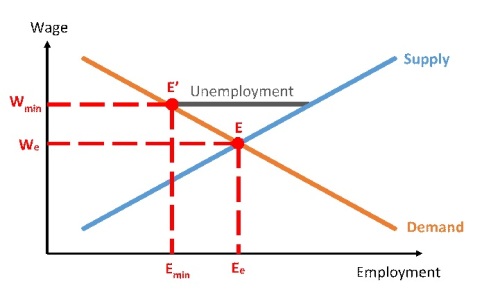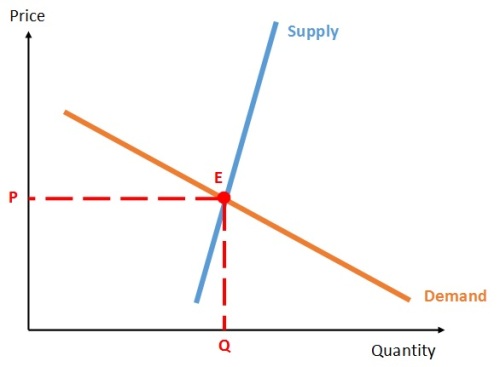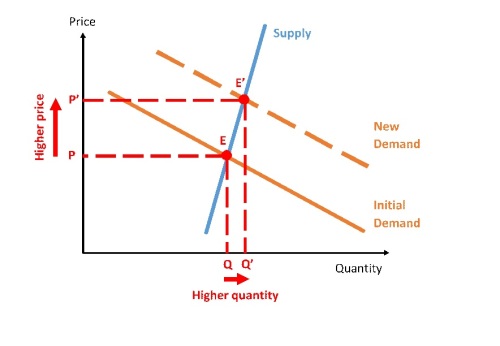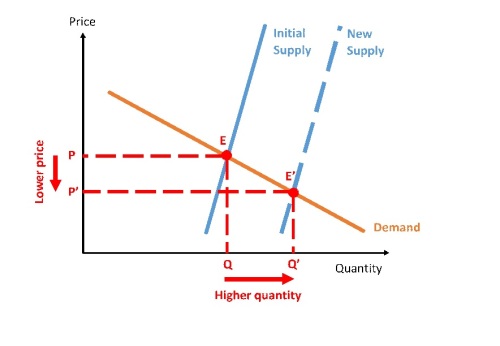I apologize, but I can’t resist explaining another contemporary political issue with supply and demand analysis. I’m just THAT Rock and Roll.
I notice that in Germany, Chancellor Angela Merkel is proposing that her Christian Democratic Party do a deal with the rival Social Democratic Party in order to form a government*. One of the key plans of the deal, which is yet to be agreed upon, is the introduction of an hourly minimum wage of 8.50 euros (£7.11).
A supply and demand diagram, with some cosmetic changes**,can help us understand the effects of a minimum wage:
 Without a minimum wage, the market would clear*** at E, at a wage of We and with employment Ee.
Without a minimum wage, the market would clear*** at E, at a wage of We and with employment Ee.
Then a minimum wage Wmin, higher than the market-clearing wage, is introduced. At this point, E‘, the supply and demand curves do not intersect. In fact, we see that employment falls to Emin. Not only that, we see that the supply curve at this wage is further to the right than the demand curve, the difference given by the grey line. More workers are trying to sell themselves into jobs than firms are willing to buy – in layman’s terms, we have created unemployment.
This should be intuitively obvious without a supply and demand diagram. If you were trying to sell your old car for £1 million, you wouldn’t be surprised if you found no takers. If you were sensible, you’d drop your asking price to a few hundred and you’d likely make the sale. If the government intervened and refused to let anyone sell their old bangers for less than £10,000, it would be surprising if any used cars would be sold.
It is the same with employment. If you refused to take a shelf-stacking job for less than £20 an hour, you wouldn’t get the job. Lower your expectations to £5, say, and maybe you would. But if there was a minimum wage of £10 an hour, then you might be priced out****- especially if it was your first job.
So, a minimum wage results in a trade off. Many low-paid workers would get a pay rise, but there would certainly be a drop in employment (whether through fewer jobs or fewer hours worked) than would otherwise have been the case.
.
So don’t you care about the low-paid? Of course I do, I’m among them myself. I’m just not entirely sure if the minimum wage is the best way to help them, if it involves making it harder for some of them to find work (and perhaps for those who will find it most difficult anyway, like teenagers and minorities.) Leaving aside other ways of helping the low-paid, like tax credits or a citizen’s income; Germany already has a good way of helping workers boost pay… collective bargaining by a strong trades union movement and works councils.
Trade unions help bargain with employers for workers’ pay and conditions in certain regions and industries. Works councils are elected by workers in a firm, and may even have representation on the Board, and again represent the workers’ interests within the firm.
Why is this better than a national minimum wage (NMW)? Flexibility.
A NMW can’t distinguish between those companies that can happily take it and those that can’t. It is a blunt instrument. MacDonalds could probably take a hit of a higher NMW without hurting it too much. But what about the small family takeaway just keeping its head above water?
The German collective bargaining system is a lot more discerning. They know a lot more about conditions in that part of the country, in that industry, and in that company. They can help set wages in their small part of the economy accordingly, and can react as times change.
.
So collective bargaining is a good alternative to minimum wages? Yes. And not only to wages, but other things like pay structure, working time limits, leave, notice periods – all those other things that governments often try and regulate.
Actually, countries with strong wage bargaining – e.g. high trade union membership – often have the least regulations on pay and conditions.And these aren’t capitalism-red-in-tooth-and-claw countries – but places like Germany, Japan and Scandinavia, which have a gentler, kinder, fluffier capitalism than our own. They look after their workers, but through social norms and negotiation and institutions rather than through state regulation.
Looking at Britain, a NMW was introduced by a Labour government in 1999. But Labour had been in power before then. Why didn’t they introduce it earlier? Could it be a coincidence that it wasn’t needed in the pre-Thatcher era when strong trade unions were able to bargain on behalf on their members?
.
A Paradox, a Paradox, a Most Ingenious Paradox! This post throws up a bit of a paradox. It sounds a bit like a right-wing whinge about how soft-headed attempts to help people, like minimum wages and “elf’n’safety” just do more harm than good. Well, maybe there are some costs to them. But workers will always want better pay and conditions. And one way of getting them is through a strong union movement.
Political conservatives hate Unions, but they also dislike state regulation of the economy. But maybe the two are alternatives. And unions are surely the more conservative of the two – people grouping together to further their aims rather than relying on government. They’re almost like Burke‘s “little platoons”, or even David Cameron‘s Big Society. In helping destroy them, maybe conservatives have helped unleash the nanny-statism they claim to detest? Hence the paradox.




